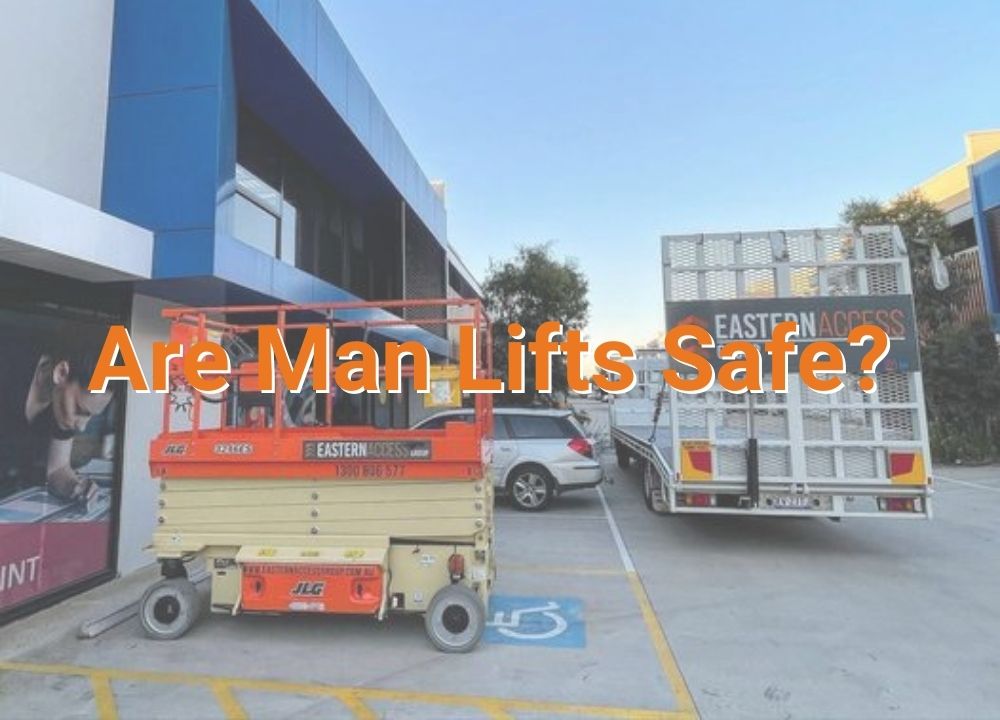Are Man Lifts Safe?
Did you know that if you use a man lift, an essential factor to protect is your safety? Many professionals recommend ensuring that any work you plan to do requires a man lift. You can enjoy numerous benefits when choosing this approach, from home improvement projects to factory floor repairs and even on construction sites.
But before jumping into that platform, read further to know all the basic things necessary about using man lifts to avoid errors that can lead to injuries while using these aerial work platform devices.
Table of Contents
What is a Man Lift?
Aerial lifts are portable platforms attached to vehicles that raise people. These lifts are an excellent alternative to scaffolding for jobs that are difficult to reach and require access to high places like roofs and HVAC equipment. Nonetheless, it’s crucial to put safety first when using this equipment.
Man lift is an aerial work platform (AWP) designed to securely lift workers and their tools on indoor and outdoor construction projects. They differ in size, appearance, and function from other aerial lifts like boom lifts. In the industry, they are also referred to as man lifts, personal lifts, and personnel lifts, among other terms. There are three types of man lifts belt-driven, push-around, and self-propelled. They all range in size and have various skills.

Man Lift vs Boom Lift – How Do They Differ?
Man lifts are used to transport heavy objects and materials. They can also be called boom lifts, lifting platforms or even self-propelled elevators. Man lifts are sometimes confused with scissor lifts (which is an acronym for “self-extending” or “scissor” lift). Still, critical differences between these two types of equipment should be understood before purchasing either one.
A man lift is a type of boom lift that is used to lift heavy objects. It has two sets of wheels, one at the bottom and one at the top. The wheels on the bottom can be pushed back by a hydraulic pump to lift an object like a ladder or piece of furniture.
A boom lift has three main components: an arm with a base plate, which is attached to a platform; another arm that connects to this first arm (the boom); and finally, an attachment point for moving material such as logs or lumber beams onto a said platform so it can be lifted out from underneath them during construction projects such as building houses or other structures where there needs to be extra support added into place quickly without having anyone walk inside them yet!
Common Hazards Associated with Man Lifts
Man lifts are a great way to work around your home or business. They’re also a significant safety hazard, however. Here are the most common hazards associated with man lifts:
Inattention to safety
The most common hazard associated with man lifts inattention to safety. This is the most common cause of injuries and fatalities. Man lifts are large, heavy and awkward equipment requiring training before being operated safely. The problem is that most people using them need training or supervision on correctly using them. They may have been trained in the past but have forgotten their lessons or have never been trained at all.
Slips, Trips and Falls
Slips, trips and falls are common hazards associated with man lifts. Because of the size and weight of these types of machines, there is a greater likelihood for an accident to occur when compared to other types of equipment. People often need to think about what could happen if they fall off a platform or slip into another area where they cannot escape quickly enough. It only takes one second for something terrible to happen if someone falls off a platform or slips into unsafe areas while using their man lift.
Lifting Equipment Malfunction
Man lifts can malfunction, causing the user to fall. This is a hazardous situation as it could lead to severe injury or death. To prevent this, you should always follow safety guidelines and take safety precautions when using your man lift.
Falling Objects
Man lifts can fall over if not properly secured or anchored. If your man lifts fall over, it can cause serious injuries or even death if someone is standing underneath it when it falls over.
Collisions
Some people may think that being on a man lift doesn’t pose any danger because they’re higher than other elevators. However, many dangers are still associated with being on a man lift, such as accidents caused by other pedestrians who need to follow traffic laws or look where they’re going when walking near a man lift.
Electrocution
Electrocution is the leading cause of injury-related fatalities in the lifting industry. Electric lifting equipment is used in many industries. Still, it is hazardous if misused or without proper safety features. For example, some man lifts use a cord plugged into an electrical outlet or a portable power pack that attaches to the machine. The cord is then connected to an extension pole or boom arm that extends above the ground and comes into contact with overhead electrical lines or other conductors. This can result in electrocution for anyone working on the lift operator’s side of the machine and anyone working on the other end of its boom arm, which may have touched something metallic with their hands during work.
Injuries
Man lifts are designed to hold a significant amount of weight, so it’s easy for workers to injure themselves if they slip or trip while lifting something heavy. Many injuries occur when workers don’t have enough room to move around comfortably while lifting something heavy, leading to stress fractures and muscle strains in their backs and legs.
Safety Precautions in Using Man Lifts
When working with a man lift, you must be careful to avoid some common hazards associated with this type of equipment.
Man lifts can be very dangerous if not used properly. Here are a few tips for avoiding injury:
1. Ensure the hoist is in good working order before using it. If it’s not working correctly, put it away until you can get it repaired or replaced.
2. Always wear safety glasses when using a man lift and other power tools in your workplace area. Please keep your hands free from rings or bracelets while operating these machines so that they don’t get caught on them and cause injury to yourself or others nearby.
3. Ensure all cables are correctly installed on the man lift before use; otherwise, they could become damaged and cause an accident.
4. Always ensure the ground beneath your workplace area is stable before placing any equipment above it, including a man lift.
5. Ensure you read the operating manual and follow all its instructions. If you do not follow the instructions, it may lead to accidents or injuries.
6. Always ensure no flammable materials are around your work area or the man lift.
7. Make sure that no sharp objects are lying around the area where you work with the man lift. These can cause injuries due to cuts and bruises during accidents when these objects fall from above on your head or body parts like arms and other parts.
8. Never work on any platform without proper training from an expert who knows how to operate them safely so that there is no chance of any mishap occurring during use.
Frequently Asked Questions
Employers are responsible for ensuring man lift equipment is well-maintained, inspected, and used safely. Employees utilising man lifts should be adequately trained and informed of possible risks.
Man lift equipment is often safe if sufficient safety precautions are taken. But, if they are not utilised correctly, or maintenance needs to be updated, accidents can occur, just as with any other heavy gear.
Whenever a man lift piece of equipment presents a safety hazard, you should cease using it immediately and notify the manufacturer or your supervisor of the problem. Never try to solve the problem on your own.
Alterations to man lift equipment should only be done with the manufacturer’s approval. Only approved alterations can undermine the equipment’s safety and result in mishaps.
Conclusion
Unfortunately, every scissor lift battery ultimately loses its capacity to recharge and function properly. Your lift’s performance and lifespan are greatly influenced by the regular upkeep and maintenance you provide it and its batteries. Regularly carrying out easy maintenance might help your batteries last longer. The batteries should be charged following the manufacturer’s advised instructions specified in the machine’s operator’s handbook once the equipment is locked up for the day. The battery must be in good condition to ensure operating safety and optimal machine performance.

